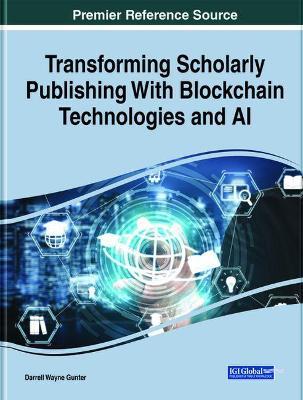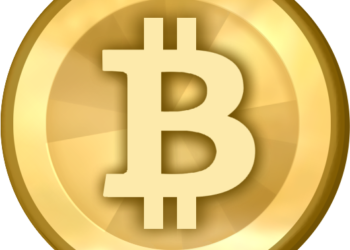Today we feature an interview with Darrell W. Gunter. I was privileged to get to know Darrell through his leadership in the STM Association and have followed his work since then on the impact and potential of new technologies on scholarly publishing.
Darrell is the editor of a new book on Transforming Scholarly Publishing With Blockchain Technologies and AI. This book contains contributions from several dozen guest contributors and a number of pieces from Darrell, reflecting on these new forms of technology and some of the ways they may impact the scholarly publishing sector. In today’s interview, Darrell speaks at length about the sector, its history, and some of its future directions.

You’ve been involved in the scholarly publishing sector in several roles over the course of time. What kinds of changes have you seen in scholarly communications?
My journey started after I graduated from Seton Hall University when Xerox hired me to be a Marketing Representative selling copiers to local businesses in a few towns in NJ. On my first day at work, I walked into the demo room a saw the Xerox Star System. In 1981 it was the state of the art word processor. The monitor featured icons (files), a keyboard, and a mouse. After playing with the Star System, I asked my manager if I would be able to sell it, he explained that Information Services Division represented it. This interaction with the Star System prompted me to purchase the Xerox 820 computer, which featured two 5 1/4 floppy disks.
I stayed at Xerox for two years, then was recruited to Dow Jones Financial News Services and DJ News Retrieval (Factiva). So my digital journey would begin at Dow Jones, and over my 13-year tenure, it prepared me for the most significant industry transformative experience at Elsevier.
Elsevier selected me to be the first RSO Director for the Americas. The three strategic objectives were to build the organization, which consisted of sales, marketing, customer service, and IT, convert their print business to digital with the launch of ScienceDirect, and introduce long-term agreements. During my 11 years, my team successfully launched ScienceDirect, Scopus, College Markets, BioTechSelect, and dozens of other digital products.
At some point, John Regazzi introduced me to Steve Leicht, who was the COO at Collexis. Steve shared with me a wireframe of BiomedExperts.com and demonstrated the Mediator application with its Semantic Search. The two products represented the next steps of innovation in the STM industry. Biomedexperts.com would become the LinkedIn of scholarly researchers, and Mediator with its Semantic Search would transform how researchers conduct their search.
The following two years, we spent considerable time educating the marketplace about Collexis and our semantic search. It took us two years to get on the podium of the STM annual meeting. But we built the company to $6 million in revenue in three years and then sold it to Elsevier.
I have been very blessed to be at the crossroads of the industry and new technology, and after being the pied piper of semantic search, which uses AI, I found myself in a similar position with Blockchain. My first impression was that the industry was not giving this new technology a fair shot. For example, a reminiscence of the 2001 PSP meeting held a panel debating whether books would be fully digitized. I believe that several publishers held off on digitizing their book collection based on that panel.
It was clear that too few individuals understood the potential impacts of Blockchain on our economy, let alone on our sector. I needed to learn more about this technology and signed up for the executive course at MIT on Blockchain. A lot of folks were deep into Blockchain in exciting ways. During the seven-week course, weekly case study assignments required you to apply that week’s lesson to an actual application. It allowed me to expand my thoughts and understand how Blockchain technology applies to the scholarly publishing industry.
So, where are we in the digital transformation of the sector?
My view is that we are in the stone age. If you look at AI and semantic search — it hasn’t taken off. Folks are still using a standard boolean search. AI can be used in so many different ways. Blockchain is very early days and has so much great promise. Unfortunately, it is equated to cryptocurrency, but it’s not about that at all.
This is my caution to publishers. You don’t want to be Telerate. Telerate had 100% of the market before Bloomberg. Bloomberg had better analytics, better customer service, better user experience. Unfortunately, the Bancroft family took a multibillion-dollar bath with Telerate. A lot of publishers are very hesitant to try Blockchain. Someone will create a better mousetrap that will make publishing so much more effective than it currently is.
I remember speaking with a librarian in 1999, as we were rolling out ScienceDirect, who insisted that the internet would go away and print would resurge. We’ve had so many panels about whether ebooks will ever come to fruition. In this industry, we make the error of ignoring so much new technology — it’s great to challenge it for efficacy — that debate is always worthwhile, but any new technology shouldn’t be dismissed outright.

It’s clear that there are real business impediments facing the major incumbent houses in adopting new approaches to technology. Is the startup ecosystem, therefore, the way to address these?
It’s all about the ecosystem. This industry has the tools to create what is needed. We’ve done it with the DOI, CrossRef, and ORCID. Eefke Smit has led many industry-wide projects with the STM STEC group. The industry comes together when projects are in everyone’s interest.
What this industry does best is gather content from quality researchers. But they are creating all these interfaces because everyone feels they want to own the desktop. But unfortunately, the only one who owns the desktop is the user, who will choose how they do their work. In my opinion, Elsevier has the semantic search technology and chooses not to deploy it fully. Likewise, Google has the technology and chooses not to use it. Probably because more precise search results in fewer pages and ads.
To your point, a startup can introduce a new Blockchain application, and it can be the better mousetrap. Then someone big acquires them, and the latest technology gets shoved in the closet, like GM acquiring the railroad in LA in the 1930s so they could shut it down and sell more cars. That is not the approach we need to see.
I hypothesize that the long-term ROI for Blockchain will be beneficial to all stakeholders, including the librarian community, who will support this because it will decrease costs.
As you know, there is a good deal of skepticism in some parts of the sector about Blockchain. What is an actual use case for Blockchain?
Blockchain is a distributed ledger that is a glorified Excel spreadsheet. Blockchain provides clarity and transparency. In accounting, parlance clarity and transparency represents having checks and balances. That’s what Blockchain does.
Let’s look at peer review. Double-anonymized, open, crowd-sourced — put that aside. In traditional peer review, an author submits a paper. If the peer review system is derived from Blockchain, you’ll see when the article was received, when sent out for peer review, when replies are received. It provides clarity and transparency to the author and others about the process. Items are not lost; there is no miscommunication.
Of course, there is no silver bullet, and Blockchain doesn’t have a monopoly to solving these problems, but it is a compelling technology. For example, a production process on a blockchain would be tremendously streamlined. On the other hand, Blockchain runs the risk of displacing existing businesses.
 And who is using Blockchain effectively?
And who is using Blockchain effectively?
There is a real gap here, a real opportunity space. Springer Nature, Taylor & Francis, Digital Science had a promising project for peer review utilizing the distributed ledger model. But that has come to an end. There is something going on for peer review, but not commercially available in the marketplace. However, I have had confidential conversations with a few industry colleagues exploring use cases utilizing Blockchain.
In the book, we provide current products and services that are using Blockchain and other future potential use cases.
And how about AI applications — what can we expect to see there?
Recall and Precision are critical. Recall is defined as bringing back all relevant search results. Precision is defined as the search results will be in context to the search. For example, a search term, “Dolly, the Sheep, would not bring back a search result including Dolly Parton or the River Jordan, not Michael Jordan. Semantic search understands the entire context of the search query, could be a paragraph or a full paper, where you digitally fingerprint it to understand its words. We can bring forth better and faster research by providing the correct information in context.
What does this mean for you? Where are you going next?
My business is consulting as an ongoing concern. I’m contemplating my next steps in Blockchain and AI as I am having discussions with a third-party developer about doing something in one of these areas. I am also in talks with a couple of groups to see what we can do. I have a hypothesis that blockchain and semantic search can help serve the researcher and open up scholarly research to the long tail on a more affordable basis.
My predictions about technology and business models have been pretty good throughout my career, and I am betting that Blockchain technologies and AI will usher in substantial new opportunities for the industry,
This book’s goal is to help people ask the big what-if questions, think big about the problems we are trying to solve, and not just be protective and defensive about the status quo. I hope that the leadership within the industry educates themselves about Blockchain and AI and engages in thoughtful Blockchain and AI projects.
Discussion
24 Thoughts on "Transforming Scholarly Publishing With Blockchain Technologies and AI: An Interview with Darrell Gunter"
I started this article with one question, “Why blockchain?” And after reading that blockchain is “a glorified Excel spreadsheet”, I am still wondering.
What does blockchain offer that a traditional database, properly looked after by trustworthy people, does not? Can a traditional database not be used to show a peer reviewer metadata about a paper or to record details of the review process? Is it really a better mousetrap or is it the same mousetrap but with more buzzwords and a bigger carbon footprint?
I have to agree. I find the premise interesting, but to what avail. It sounds like Blockchain would just be another way of organizing information, aka a database. Perhaps more intuitive, but how much of a difference would that make vs. as you say a well constructed database. Just this morning I was reviewing curriculum proposals in a database that seems to operate in the way blockchain is described in this interview. It was smooth and provided all the information needed and then some, I can’t see how blockchain would make a difference.
Then again when thinking about peer review and the ability to check the status of article submission maybe this would be a good application for blockchain. It would to get a accurate picture of the process since that so many submissions enter a dark void.
Dear Anonymous,
Thank you for taking the time to read the interview and provide your comments. Your comment, “Can a traditional database not be used to show a peer reviewer metadata about a paper or to record details of the review process?”, yes it can but not with the precision of the data being compiled in the Blockchain. This gloried Excel spreadsheet will change the game completely. The editor, author, and peer review group will have complete clarity and transparency as to the status of the paper. Further, when you combined AI tools and semantic search in the peer review blockchain, the Editor and Peer Review group will be able to search the paper and compare the paper to other publications. Show me a current database that is capable of these features.
The carbon footprint will be less than the multiples of people trying to develop a software service to achieve the same.
I would love to continue the conversation with you as it is important for this industry to understand new technologies and to make professional discernment as to their efficacy versus dismissing them outright. Remember this industry debated whether Books would be digital at the 2001 PSP Annual Conference.
While Roger’s questions are pretty clear and simple, Darrell’s answers are woefully lacking, tacking together business and technology buzzwords into non-sequiturs.
I hypothesize that the long-term ROI for Blockchain will be beneficial to all stakeholders, including the librarian community, who will support this because it will decrease costs.
or
Of course, there is no silver bullet, and Blockchain doesn’t have a monopoly to solving these problems, but it is a compelling technology. For example, a production process on a blockchain would be tremendously streamlined. On the other hand, Blockchain runs the risk of displacing existing businesses.
or
I have a hypothesis that blockchain and semantic search can help serve the researcher and open up scholarly research to the long tail on a more affordable basis.
Did Roger just giver Darrell a platform for promoting himself and his business?
Dear Downright Puzzled,
My track record of discussing, launching, and implementing new technologies is well known. Being involved in this industry since 1996 and the information industry since 1983, I have witnessed several new technologies that we ignored in the beginning only to become the dominant application because of the efficiencies it brought to the market.
In 2011 I published a chapter on Sue Polanka’s edited volume and you find my published articles in my ORCID profile. My dedication to the scholarly publishing industry is to improve scholarly research. You are welcome to join me in a professional dialogue at any time.
Sincerely,
Darrell W Gunter
Agree with the previous. The conversation was somewhat convoluted and unclear; it felt the interviewee jumped all over the place and other than the description of date stamp on the review process, I didn’t really come away with any more understanding than I went in with. Surprised too at the promotion of a book published on what I consider a questionable publisher.
Anonnelly, I welcome to have a conversation with you to address your questions. My question to you and the scholarly publishing industry is, what improvements are you suggesting to improve the scholarly research process?
The technologies (Blockchain and AI) are only limited by our knowledge, skills, experience, and willingness to try new ideas and if it fails, fail fast and do not lose the intellectual capital gained by that experience. The lightbulb was not created in one try.
“put that aside. In traditional peer review, an author submits a paper. If the peer review system is derived from Blockchain, you’ll see when the article was received, when sent out for peer review, when replies are received. ”
I don’t think workflow automation and tracking is within the scope of blockchain. That would still be handled by a traditional application. What blockchain can do is remove the “rights and ownership” determination from that application such that it cannot be manipulated by the app administrator. In the case of a peer review system, I suppose that may translate to a record of a peer viewer’s participation in the article approval process that cannot be disputed by the peer review system’s administrator.
Hi David,
Thank you for your comments. Note that there are many other potential applications for Blockchain and AI technology. Smart Contracts, semantic search, commercial purchase options, improving citations, etc. We are only limited by our imagination.
There are of advantages to using these technologies in certain situations but all too often the terms are used to hype a product. To me I often interpret “Our product uses AI” as “Yes but this one goes to 11”.
Most problems can be solved with traditional algorithms and without AI. However, it is often expected that you have some form of AI in your product. AI is just and extension of traditional algorithms where statistical measures are used to make decisions based on a large amount of data input. I think its important for people to explain what areas of their system benefit from AI to avoid the hype.
Regarding blockchain- In your article you said:
“In traditional peer review, an author submits a paper. If the peer review system is derived from Blockchain, you’ll see when the article was received, when sent out for peer review, when replies are received. ”
I would disagree in that with both traditional and blockchain applications you could see this workflow as long as that functionality was was built into the system. Just like with AI, I think it’s important to explain how blockchain differentiates itself from traditional applications. As I repeated throughout this thread – blockchain is about the determination of “rights and ownership” of content .
This is such a small piece of a much larger application in the same way as the mechanism by which you login. If there comes along a new and better way to authenticate a user in a system, I would think that one would need to explain how that new login differentiates itself rather than implying that systems not using that form of authentication cannot solve the same problems as a whole.
agree entirely with the above comments.
blockchain is a (nonworking, and incredibly expensive) solution in search of problems. the idea that there is a problem in peer review around the trustworthiness of documents submitted during the review process is absolutely bizarre. i work with and have worked with peer reviewers at every stage of the process for many years, and never even encountered the idea that people might be *trying to* counterfeit reviews for others, or inserting false documents into the process, such that editors would not catch them–let alone that anyone has gotten away with this bizarre bit of fraud.
the real story here is why it is that publishers and universities can be so hypnotized and badgered into keeping up with technological promotion that they feel they need to listen to or worse pay for consulting that is completely disconnected from reality. when the distributed ledger model for peer review failed it wasn’t because there is a “gap” or “opportunity space” that went unfilled. it’s because there is no problem there that the blockchain boondoggle needs to solve, even if it could solve any problems rather than creating them.
You may have never encountered (or perhaps you have encountered but are unaware of) fake or counterfeit peer reviews, but they have indeed become an issue. Some examples here:
https://retractionwatch.com/2017/04/20/new-record-major-publisher-retracting-100-studies-cancer-journal-fake-peer-reviews/
https://pmj.bmj.com/content/93/1102/499
https://pubmed.ncbi.nlm.nih.gov/33146787/
I think there is an argument for blockchain within STM. However, I don’t really see how fraud such as plagiarism or fake reviews would be solved with this technology. I think what you would get with blockchain is a record of ownership of content ( in this case fake content) that cannot be disputed by a central authority. How would that help prevent this type of fraud?
Maybe the argument for blockchain could be made with a better example such as author rights of ownership of articles hosted on major platforms.
Hi Pomp,
Thank you for your comments. I am not surprised by everyone’s comments as this industry has a history of taking its time to understand how new technology can be adapted into the scholarly publishing ecosystem. My concern is how a very vocal minority outright dismisses the technology without fully understanding it. Keep in mind that it took Elsevier 5 years to achieve 100% penetration of ScienceDirect in the US.
As I have offered to the other folks who invested the time to post a response please feel free to contact me for a discussion.
Let’s call a spade a spade. Today’s post is a promotion for a new book written by an industry veteran. Our community would have been better served by a post about “blockchain and AI in scholarly publishing” offering multiple perspectives from within and outside our industry. Funny…TSK’s prohibits “comments that are blatant bits of self-promotion, selling one’s products or services” but does not apply the same standard to its own posts. It seems that TSK is increasingly becoming an outlet for shameless promotion of products and services. Far from its origins. Among the most painful posts to read are those by select TSK chefs who are also industry consultants, where that faint whiff of self-promotion is undeniable (one chef/consultant comes to mind). Has SSP considered offering a category of “sponsored” TSK posts? This would be a new revenue stream for SSP while providing the transparency our community deserves. Of course, parameters would have to be established for sponsored posts.
Thanks for your thoughts. As the editor of this site, there is always a line to tread, that can sometimes become blurry. I’m not sure why this post would be considered any more of a promotion for a book than any other book review or interview with an author (e.g., https://scholarlykitchen.sspnet.org/2012/04/11/review-how-economics-shapes-science-by-paula-stephan/ and the accompanying interview https://scholarlykitchen.sspnet.org/2012/04/11/interview-with-paula-stephan-economics-science-and-doing-better/). We also regularly profile individuals (e.g., https://scholarlykitchen.sspnet.org/2021/06/01/guest-post-leave-the-party-while-youre-having-fun-an-interview-with-suzanne-bedell-upon-her-retirement/) and companies/products (e.g., https://scholarlykitchen.sspnet.org/2021/03/15/start-up-stories-skilltype/). I’m not sure this is a new phenomenon, but we do our best not to cross that line. Posts are essentially based on what interests an individual author, and again, if you’re doing a project where you want to share the lessons learned, it’s not really possible to do that without revealing your own role in it, which some may consider self-promotion.
As for your request for a post about blockchain in scholarly publishing, we have you covered (content warning, one of these posts was written by a publishing consultant, so caveat lector):
https://scholarlykitchen.sspnet.org/2019/06/27/what-is-the-blockchain-really-and-should-you-care-a-guide-for-the-perplexed-scholarly-publishing-citizen/
https://scholarlykitchen.sspnet.org/2018/04/03/everything-always-wanted-know-blockchain-afraid-ask/
https://scholarlykitchen.sspnet.org/2018/04/05/can-blockchain-withstand-skepticism-an-inquiry/
Hello Anonymous,
If you would check my credentials you would learn that I have been a consistent advocate to promote the best interest of the scholarly publishing industry. Being responsible for the launch of ScienceDirect, Scopus in the Americas for Elsevier and the launch of BiomedExperts, Reviewer Finder for Collexis, and working with STM on the curation of their STM Annual US Conference and STM Frankfurt Conference, etc., demonstrates my serious intent for the industry.
My personal mission is to play whatever part I can to advance scholarly communication. For you to think otherwise demonstrates that you do not me at all.
I welcomed a positive and focused dialogue with you. Please feel free to contact me.
I would like to know more about the potential environmental impact of ecosystem-wide adoption of this approach. We as an industry seem to love talking about sustainability of different infrastructure approaches, and it feels particularly important to consider this up front here.
Dear Anonymous,
This interview is all about educating and not promotion. The contribution of 16 chapters from authors from all around the world demonstrates the importance of the topic. I have given similar interviews to other publications and have not experienced such resistance to discussing this topic. It has been my experience that some people push back on what they don’t understand. In 2018 I decided to enroll in the MIT Blockchain course and my recent hypothesis about the potential applications was born out of my learnings.
I am very appreciative of the Scholarly Kitchen to publish this interview as my goal is to play a positive constructive role in the advancement of scholarly publishing. Anyone who knows me will attest to my commitment to bringing new ideas, products and services to advance the industry.
I welcome the opportunity to have a full open discussion with you.
Note that the traditional Blockchain with miners does take up a lot of energy but a publish establishing their own Blockchain based on their requirements will not require the same amount of energy.
Perhaps it’s best not to ask “why blockchain?”, but to focus on what is possible with decentralized networks. Google is an example of a centralized infrastructure in the sense that their server farms are under their control. Science Direct is a centralized database of scholarly content, they determine who gets access through their pricing model. Clarivate owns nearly everything now, their business model is based on centralizing data.
Decentralized platforms are not held or supported by large for-profit organizations. In the case of peer review, you might imagine an ally similar to ithaka, acting as an open source peer review hub that scholars across the world could submit content to. Instead of housing that content on a centralized server, bits of it would live on computers who choose to participate in the project. To us, a distributed model seems radical, yet peer-2-peer systems were what the original world wide web was supposed to be.
The IPFS https://ipfs.io/ makes this possible. The mechanism it uses to insure the security and authenticity of the data is blockchain.
TLDR- Focus on the benefits of decentralized infrastructure rather than “blockchain”
The determination of “rights and ownership” of content is such a small piece of a much larger application. I don’t think there is an assumption that if you want a decentralized mechanism such as blockchain, you’ll have to port the entire platform to a peer-2-peer architecture.
While I may be a little late to this conversation, and while I am far from an expert on blockchain, I wanted to offer a few thoughts that have been rattling around in my head as I observe exciting trends on other publishing landscapes… particularly, the financially-wild craze in the selling of NFTs (non-fungible tokens) as digital artwork.
While this TSK post and its comments seem to focus on peer review and other operational aspects of traditional journal publishing, it occurs to me that for the most part, we are missing the point of blockchain! It is the “purity” of the distributed ledger as a secure and rights-based transactional record that is the key.
We are not yet seeing the full value of blockchain’s operational capabilities, because, as of now, there are very few browser-based exchanges upon which to interact with blockchain technologies. Yes, there are a host of financial exchanges, apps, and wallets related to cryptocurrency, but unless you’ve gotten-in early or you are playing with Dogecoin or other meme currencies, this means of interacting with the blockchain may not interest you… but it should! These are the building blocks to the future of all verifiable digital transactions.
You must, at minimum, now take notice that there are browser-based marketplaces to buy and sell NFTs, using cryptocurrency. While OpenSea (https://opensea.io/) may currently be the largest such marketplace, there are many others popping up, and certain traditional crypto exchanges like Binance are also getting into the game of facilitating the buying and selling of published digital assets.
In these blockchain marketplaces you are basically buying/selling the rights to digital intellectual property. In some cases, you can not only set the terms of sale and rights of ownership, but you can set the terms of resale so that the original owner financially benefits from any further financial transaction related to the digital asset, perpetuity (the beauty of the digital rules coded into the original blockchain transaction).
So this brings me full-circle back to scholarly publishing. Why not e-books? What better way for a publisher to lock-in rights to a digital asset like an e-book. Ownership is traceable and verifiable. The publisher can ascertain rights and determine the monetization of its sale, the distribution of royalties to the authors, and the conditions of any resale (forked transactions) by secondary or tertiary owners — all secure, traceable, and verifiable via the distributed ledger on the blockchain.
To me, THIS is the reason why scholarly publishing needs to sit up and take notice of these technologies — before others create the infrastructure for them. As such, publishers also need to be open to cryptocurrency as a form of payment, and begin to align with platforms which are designed to manage such digital transactions. It won’t be long now, before the buying and selling of digital assets expand beyond artwork, music, and other collectables. The future is now, and it is happening quickly in the hands of those much nimbler than I, and I fear, much nimbler than our traditional publishing infrastructure.
Hi Donald,
Well said!
Best,
Darrell W Gunter



